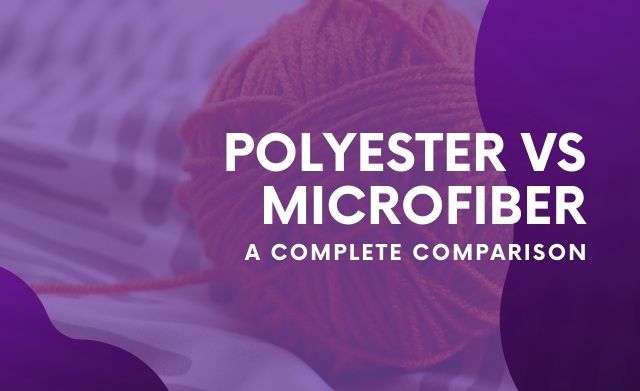
For many, it becomes confusing to recognize various fibers. This article contains the difference between polyester and microfiber to help you choose between these commonly known man-made fibers.
There are some manufacturing similarities between these two fibers. Yet, they differ significantly from each other in several ways, like their origins, usage, texture, and many more.
Polyester fiber first came into existence in 1941 and was invented by two British scientists named W.K. Birtwhistle and C.G. Ritchie. Since then, along with other commonly used fabrics like cotton or silk, polyester has become a large part of the fashion and textile industry.
On the other hand, It’s confusing to know about the exact period of microfiber’s invention. Some say microfibers were invented in the 1970s, while others claim it was in the middle of the 1980s in England. However, microfibers were first commercially produced in the 1990s in Europe.
When talking about fabrics, polyester and microfiber both are popular that are used in a wide range. Polyester fabrics are less wrinkle-prone, easy to wash, and absorbs water in a low volume. At the same time, microfiber is famous for its higher water absorption ability, dust, or dirt-attracting power; hence, widely recommended as a cleaning agent.
Polyester is a type of plastic or synthetic resin where eastern functional groups connect the polymer units. Conversely, microfibers are the synthetic fabric that is made up of polyesters and other chemical compounds.
Apart from manufacturing and other scientific characteristics, we will also be discussing the difference from various standpoints for your convenience that you can choose the suitable fabric for your future usage. Let’s move forward.
Table of Contents
Comparison chart
| Difference | Polyester | Microfiber |
| Made from | petroleums, minerals, coal, terephthalic acids, mono-ethylene glycol, etc | Polyester and polyamide or nylons |
| Texture | Not soft as microfibers, strong | Soft and smooth |
| Durability | Very durable | Not as durable as polyesters |
| Breathability | Low breathability | Very breathable |
| Cost | Not expensive as microfibers | Costly than polyesters |
| Water absorbance | Lower | Higher |
| Uses | Clothing, ropes, bottles, films, filters, conveyor and safety belts, umbrellas, furniture textiles, etc | Most popular as a material of cleaning cloths |
What is polyester?
If we break down the term polyester, we find poly and ester. This indicates that the polyester is made up of repeating ester units. There are both natural and synthetic materials involved in the manufacturing process.
The chemical reaction involves naturally occurring chemicals, petroleums, minerals, coal, air, water, other organic resources, and artificial chemicals like terephthalic acids, mono-ethylene glycol, etc. The chemical process of producing polyester is known as polymerization.
Unlike cotton or silk, the texture of polyester is not very soft and doesn’t generally feel like natural fiber (although it depends on the woven and blending manner). As because polyesters are made from plastic-like properties, the fibers are naturally coarse, and so the yarns are.
Polyester fabrics are very strong, chemical resistant, extremely stretchable, and hydrophobic. Because of the low water consumption ability, polyesters are quick drying. However, they are not very good against oil-based stains because they absorb oil easily.
Polyesters are durable, wrinkle-resistant and because of the heat resistance characteristic, they are fade-resistant too.
Traditional polyesters are not very breathable, even though fabrics that are composed of fine fibers are somewhat breathable, like cotton or microfibers.
Types of polyester
There are primarily two types of polyesters. They are
PET is the most used type of polymer because of its strength and durability.
Based on the process of manufacturing, the forms of polyester may vary. Some known forms of polyesters are filament, fiberfill, tow, or staple. The textures of each form are different. While the filament and staple form is soft and is almost like cotton, the tow form is highly durable and waterproof. The fiberfill form of polyester is made from fibers in staple form.
What is polyester used for?
Not only clothing but polyesters are also used to make ropes, bottles, films, filters, conveyor and safety belts, package cushioning, and many more. Polyesters are manufactured by blending polymers and other fibers and yarns. Polymers are basically plastics that are composed of natural or synthetic large molecules.
Different forms of polyesters are meant for different types of materials. The staple form of polyester is often used to make clothing. The tow form of polyester is an excellent choice to make quilts or furniture textiles like upholstery. Polyesters are also used to make umbrellas, tents, backpacks, jackets, hats, blankets, etc.
What is Microfiber?
Microfiber consists of polyester and polyamides or nylons. Commonly there are 70%-80% of polyester, while the rest is filled up with either polyamide or nylons. This synthetic fiber is commonly used to produce washing mops, mats, apparel, industrial filters, etc.
The texture of microfiber is very soft and smooth because of the fine fibers used to produce it. The diameter of microfibers is 100 percent finer compared to human hair(this means that microfibers are excellent at picking dirt, dust, microbes, or other extremely tiny stuff up).
The best thing about microfiber is probably its absorbency ability. It can hold 7-10 times its weight in water, and as a result, they are one of the best choices as a cleaning tool or towel material. Microfibers are durable (but not as polyesters), washable, and a piece of microfiber cloth can be used hundreds of times repeatedly for cleaning.
They are ultra-soft and lint-free, so less chance to leave any scratches on the surface. However, you should avoid using them on hot surfaces because the thermoplastic materials used to produce microfibers increase their heat-consuming ability.
Microfibers are more breathable than other polyesters but not more than cotton.
Types of microfiber
Most common types of microfibers are made by a blending of polyester and polyamide or nylons. Based on the manufacturing process and the elements, the types of microfibers vary. Some microfibers are thinner, while some are thicker. Different microfibers are used for different tasks. Some common types of microfiber cloths are tarry style cloths, flat weave cloths, ultra-plush cloths, etc.
What is microfiber used for?
Microfibers are mostly used to make knits, mats, and especially cleaning products. The tarry style microfiber is a good choice as a towel material and general cleaning tool. Flatweave cloth works incredibly well to clean glass or electronic materials like mobile phones, lenses, Televisions, computer screens, and so on.
The key differences between polyester and microfiber
- Polyesters are composed of polymers and other synthetic and natural materials. In contrast, microfibers are a blend of polyesters and polyamide or nylons.
- Traditional polyesters are rough and strong in texture. In comparison, microfibers are smooth, soft, and silky in texture.
- Yarns in microfibers are far finer than polyesters.
- Polyesters are more durable than microfibers.
- Microfiberscan hold 7-10 times their weight in water. On the other hand, the polyester’s water absorbency is very low.
- Polyesters are not as breathable as microfibers.
- Polyester is not expensive as microfibers.
- Microfibers clothes are a way better choice as a cleaning tool than polyester clothes.
Polyester vs. microfiber: comforter
So, which is a better choice as a comforter? It depends on personal preferences. Besides cotton, silk, and wool, polyester-cotton blends are also very popular as comforters/
The comfort factor of a fabric depends on its breathability, heat consumption, and softness. When it comes to polyester fabrics, they are naturally not breathable as microfibers, and both polyester and microfibers keep you warm.
You cannot avoid the cost factor too. Microfiber comforters cost higher than polyester comforters(yet, not higher than the silk ones). If you are looking for a comforter that costs less than silk but has enough softness and keeps you warm, you definitely can go for microfiber comforters.
But, if you are looking for a low-cost, durable, warm comforter, you may choose polyester comforters.
Frequently asked questions
Is Microfiber Polyester Waterproof?
Products like umbrellas, raincoats, tents, backpacks require waterproof clothing. So, microfiber polyester made specifically for such products can have a waterproof coating that makes the product water-resistant and durable.
Is polyester a good choice for furniture?
Polyesters are an excellent choice for upholstery that is used in furniture. The synthetic fibers used in polyesters are durable, cost-efficient, and fade-resistant.
Is a Polyester Comforter Comfortable?
Polyester comforters keep you warm. But they are not as soft and breathable as microfiber comforters. Polyester comforters are durable and costs lower.
Conclusion
Polyesters are produced by blending polymers and other materials, while microfibers are made up of polyesters, polyamides, or nylons. That might be a manufacturing distinction, but the difference between polyester and microfiber lies in several other areas too. The characteristics and usage of these two types of fibers are markedly different. This article will help you out with sorting all the places where they differ from each other.

Craig is a full-time academic and research-based article writer from California. A trained content creator who started his career as a column writer for local magazines and newspapers. His works have been published on many renowned online platforms.
